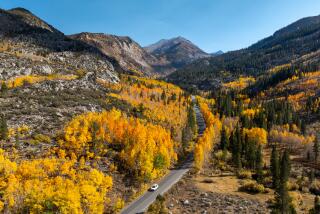Taking In a Splash of Fall Colors at Lake Powell
- Share via
PAGE, Ariz. — Forget the New England autumn color show. Turn your back on bumper-to-bumper traffic crawling along the East Coast’s well-known scenic drives.
Consider one of Mother Nature’s most colorful fall extravaganzas, Southwest style. At Lake Powell astride the Arizona-Utah border, waterfalls spill over pink limestone cliffs set off by broad streaks of rust red, brown and gray. Glass-smooth water reflects the bright red of oak brush, yellows of cottonwood poplars and rainbow variety of low-lying bushes.
Autumn is the perfect time to visit Lake Powell, a 186-mile-long dreamland of shapes etched in stone, intriguing history and opportunities for water recreation. Add the splash of color provided by changing foliage and you have an inviting alternative to one of the major annual travel treks throughout the United States.
It’s somewhat ironic that Lake Powell, such a dramatic statement of natural beauty, was created by man. The lake was formed by the Glen Canyon Dam that in 1963 began backing up the Colorado River, filling adjoining canyons and gorges.
The winding, shallow river gradually filled 96 main side canyons, transforming the rugged, high sandstone cliffs into a 1,960-mile shoreline, about 800 miles longer than the California coastline.
Sky and Water
Monoliths, towering cliffs, peaks and spires are all reflected in the midnight-blue water that seems to merge with the equally blue sky. One way to imagine the sight is to envision the Grand Canyon--through which the Colorado River runs about 140 miles more southwest--filled with water.
As the dammed Colorado River rose it covered some natural and historic remnants but made others accessible for the first time. Sandstone is particularly susceptible to erosion, and the 82 natural “windows,” arches and bridges formed by time and the elements around the lake is the greatest concentration in the world.
Rainbow Bridge, the largest natural stone arch on Earth (278 feet wide and 290 feet high), used to be reached only after a challenging climb from the river bed. Today it’s an easy quarter-mile walk from a pier.
Visitors also encounter numerous reminders of the cliff dwellers who inhabited the area, and of pioneers who explored and mined it. More than 130 miles of Lake Powell’s shore comprise the perimeter of the Navajo Indian Reservation, largest in the nation.
Evidence abounds of early Navajo life and of the Anasazi Indians, who inhabited much of Lake Powell country from about AD 700 to 1300. Hundreds of their disintegrating dwellings, pictographs (rock paintings) and petroglyph rock carvings still exist in many canyons. Passengers in boats can see some ruins, more by those who climb ashore for hikes along the cliffs.
Evidence of later pioneer and mining activity also manages to shift the imagination of sightseers into high gear. Here are ruins of shacks once occupied by miners seeking gold, copper and coal; there, the deep ruts of an old wagon trail.
‘Rainbow Turned to Stone’
On the roof of a cave and rock wall near Rainbow Bridge, sharp-eyed visitors may see the name of John Weterill carved in the stone. He etched the inscriptions on Aug. 14, 1909, the day he and a group of other explorers became the first white men to view the nonne-zoshi , the “rainbow turned to stone” spoken of by the Navajos.
If you tire of simply seeing Lake Powell with its kaleidoscope of bright-blue water and multihued sandstone cliffs, plus the added tones of autumn, there’s also much to do. Motor, sail and houseboats are available for rent at four marinas dotted around the shore. Half- and full-day cruises, and sunset dinner excursions are perfect for those who prefer to concentrate on the passing scenery.
The entire shore is open for camping. Water skiing, jet skiing, windsurfing and parasailing attract the young and young at heart. And the sheer rock walls, gravel slopes and brush-studded coves provide a prime habitat for 13 species of game fish. Among lake records are a 10-pound-plus largemouth bass, an almost 17-pound rainbow trout and a 36-pound striped bass.
A lake on the Arizona-Utah border may seem an unlikely place to head for viewing autumn’s color display. But Lake Powell has hues enough to provide a visual treat at any time of the year, along with plenty of other sights and activities. Add the bonus of fall foliage and get in on a little-known wonder.
For additional information, contact Del E. Webb Recreational Properties, Wahweap Lodge and Marina, P.O. Box 1597, Page, Ariz. 86040; (602) 645-2433.
More to Read
Sign up for The Wild
We’ll help you find the best places to hike, bike and run, as well as the perfect silent spots for meditation and yoga.
You may occasionally receive promotional content from the Los Angeles Times.






